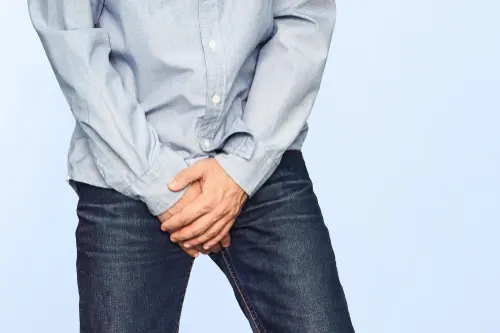How to get rid of Jock Itch
Medically Reviewed by Dr Aifric Boylan
Last updated on 11.06.2024
What is Jock Itch?
Jock Itch is a common name for the medical condition also known as “Tinea Cruris”. Jock Itch is caused by a fungus which naturally lives on the skin, but under certain conditions overgrows and leads to an itchy rash in the groin, either side of the penis and scrotum.
Generally, the skin on both sides of the genitals becomes itchy and then appears dry and scaly. It can get red and spread, becoming more intensely itchy. Scratching can lead to nicks and bleeds in the irritated skin.
Tinea can also affect the skin elsewhere, e.g. between the toes (Tinea Pedis) and beard (Tinea Barbae), so if you have Tinea on one part of the body it’s possible to “seed it” elsewhere. If you are wondering how to get rid of jock itch, there are some steps you can take to prevent and treat it.
What causes Jock Itch?
Factors that can increase the risk of tinea cruris include:
Dermatitis
If you wash your genitals regularly with soap or shower gel, the skin is more likely to be dry and irritated and so prone to tinea. The genitals should ideally only be cleaned with a hand and warm water – no loofa, soap, shower gel or other chemicals. Less is more!
Moisture and warmth
Underwear or clothes that are moist and touching the genitals for long periods of time help tinea grow. If you exercise a lot, are in a hot work environment or just sweat a lot, it’s important to keep the area dry by changing underwear if moist, or wearing looser fitting undies that allow the skin to breathe and dry.
How to get rid of jock itch- the treatment options
Jock itch can be managed in a few ways:
Lifestyle factors:
It can help to keep underwear and pants dry, avoid using soap or shower gel on the genitals, drying the skin well after a shower, and not scrubbing the skin with irritants. Other measures that might help include: not sharing towels, washing linen/towels/clothes at a high temperature, and drying them in direct sunlight.
Antifungal creams:
Topical antifungal creams can be used to clear the fungal infection faster and are available over the counter in pharmacies. Common brand names are Lamisil, Canesten and Resolve. They generally need to be used for several weeks and because tinea naturally exists on our skin, it’s common for jock itch to return. Be persistent with the cream and the lifestyle factors, particularly in warmer weather.
Corticosteroids creams can help with the symptom of itch but they don’t clear fungal infection. Combination creams which contain both antifungal and corticosteroid ingredients are more likely to effective, and include Resolve Plus, Hydrozole and Canesten Plus.
Rarely, if jock itch doesn’t clear with the above measures or there is tinea on multiple parts of the body (scalp, beard, groin), then oral antifungal medication may need to be used. For complicated cases, you may need to see a dermatologist. Speak to your GP if you need further advice on how to get rid of Jock Itch.

Getting a Mental Health Care Plan in Australia: Your Guide
Getting a Mental Health Care Plan in Australia: Your Guide Mental health matters—and if you’re feeling overwhelmed, anxious, or down, a mental health care plan can help. But what is it, and how do [...]
UTI Symptoms and Treatment: What You Need to Know
UTI Symptoms and Treatment: What You Need to Know Urinary Tract Infections (UTIs) are common, uncomfortable, and often disruptive. But what exactly are the signs to watch for, and how can you get relief [...]
Free Mental Health Care Plan Online | Bulk-Billed by Qoctor
Free Mental Health Care Plan Online | Bulk-Billed by Qoctor Discover how to get a free, bulk-billed Mental Health Care Plan (MHCP) in Australia through Qoctor's telehealth service. Accessing [...]





